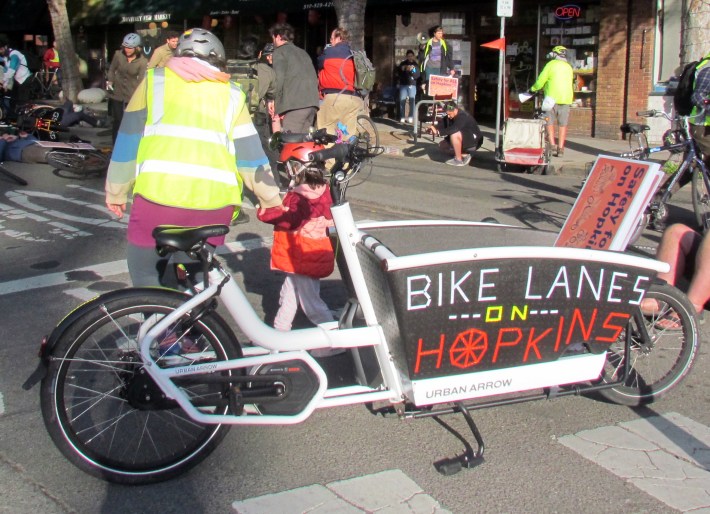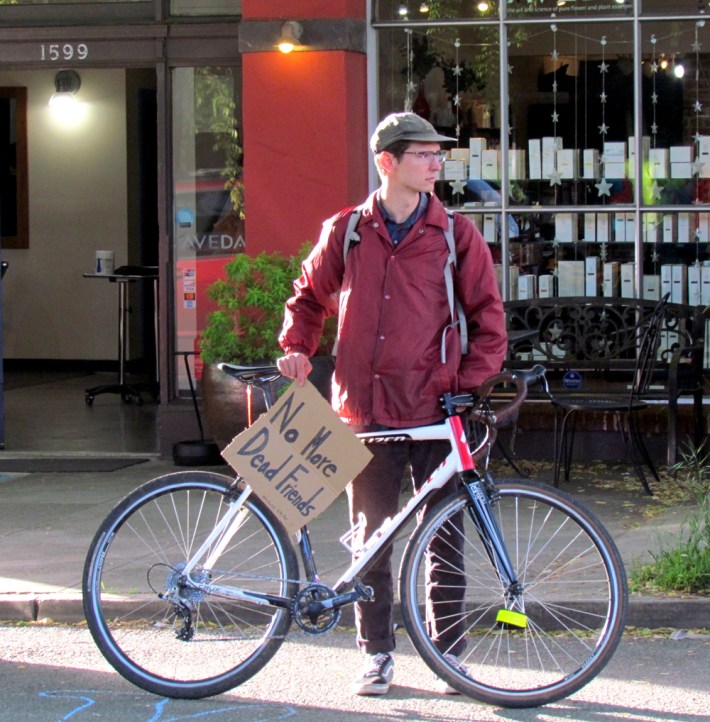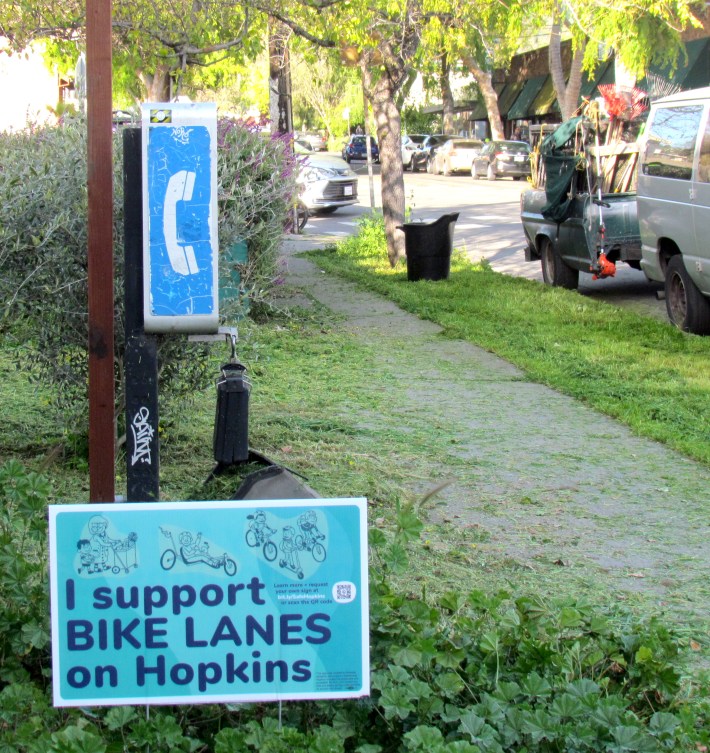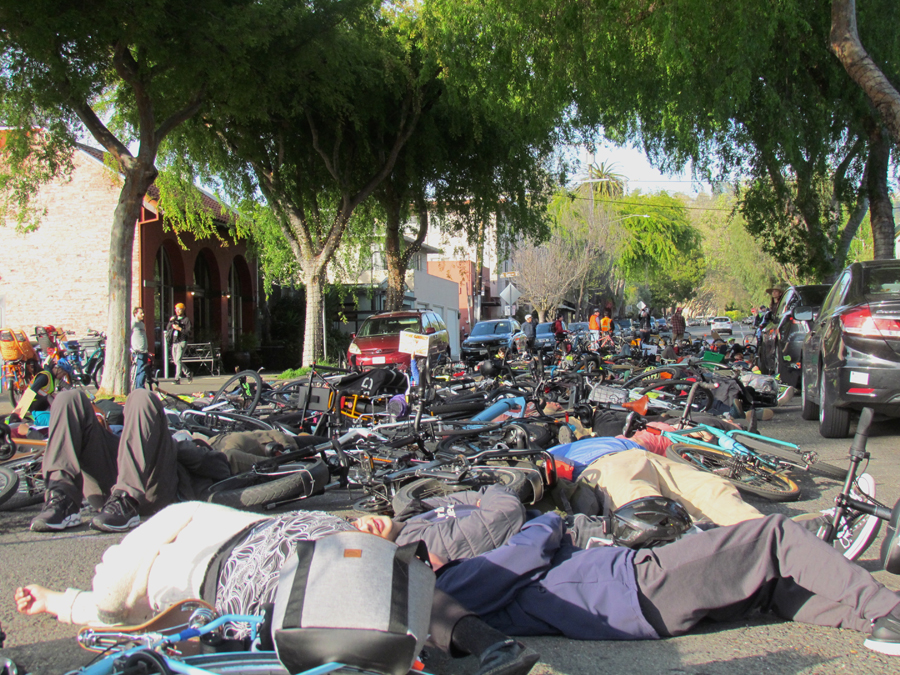When the Berkeley City Council canceled a meeting to discuss proposed safety changes along a tree-lined neighborhood shopping district, advocates who had worked for years on the project were stunned. To goad the city into prioritizing safety changes along Hopkins, several local advocacy groups sponsored a "die-in" on that section of the street Wednesday.
As soon as the #12 bus passed by, volunteers blocked the road with cones and bikes and directed car traffic around the block. Children and parents, seniors, students, and other random bike riders filled the badly rutted road with their prone bodies to emphasize the seriousness of the dangers they face navigating this part of town.

Organizers with Walk Bike Berkeley and Telegraph for People came up with this dramatic way to illustrate their fears out of frustration with the glacial progress on a plan that was approved last year by the city council to add protected bike lanes, bus improvements, and traffic calming in this busy shopping district.
"For years now, Berkeley has professed to be a Vision Zero city, committed to eliminating severe and fatal collisions," said Walk Bike Berkeley's Ben Gerhardstein through a megaphone to people gathering at the intersection of Hopkins and Monterey before the "die-in" began. "But we aren’t making enough progress."
Hopkins is a high injury street where "since 2016, four people have been severely injured and two have been killed while walking or biking on Hopkins," he said.
"To be clear," he added, "We oppose paving Hopkins without bicycle and pedestrian safety improvements. As we have seen with the HAWK beacon at Virginia and San Pablo, when safety projects are delayed, more people get hurt."

Hopkins is a key link in the city's planned bicycle network and is included in the 2017 Bicycle Plan [PDF] as a future low-stress bikeway. It needs to be repaved, but as the city moved forward with the repaving plan it also had to take into consideration the Bicycle Plan's recommendations. Advocates have been pushing for the best possible safety design that could accommodate bike riders of all ages.
Opponents reacted with panic to the proposed removal of parking, and have accused the plan's supporters of being a monolithic "radical bike lobby" out to destroy Berkeley (not a good description of the diverse crowd that filled the street yesterday, although the accusation spurred an enthusiastic response plus a t-shirt design). The councilmember for the district, Sophie Hahn, supported the design last year but then did an about-face and has been pushing to reduce or delete the safety elements from the paving project.
However, if the street is paved without including traffic calming measures, it is likely to become an even faster through-way for cars. Potholes are terrible, but at least they tend to force drivers to slow down, in a way that the presence of bike riders and people crossing the street may not.
In addition, this Berkeley corridor has few alternative routes, and none of them are great for biking. Karen Parolek, a city Transportation Commissioner who used to live close by but moved about three quarters of a mile away, described how hard it is to bike in this area. It wasn't safe for her children to bike to school at Martin Luther King Jr. Middle School, a few blocks beyond; there were no reasonable alternatives, and she felt she couldn't allow them to bike on Hopkins itself.
After years of patronizing the various shops in the area, "we had to give up coming here," she said. It wasn't what they wanted, but for their own safety, and because they couldn't figure out how to safely get through the neighborhood, they went elsewhere.
A meeting originally scheduled for last night was supposed to feature city staff presenting three options [PDF] to discuss, differentiated primarily by how far the new bike lanes extend and how many parking places would be removed. The plan was to decide on an option last night, so that bids could go out and the project could be built this summer at the same time that Hopkins is repaved.
Then on April 4, the City Manager sent out a memo requesting a postponement of that discussion, blaming "operational concerns with moving forward" that seem to stem from even deeper staffing problems.

Public agencies keep personnel issues away from the public eye, so there isn't any more publicly available information to explain why the staffing problem is suddenly dire. But as noted in a different City Manager memo, sent in December [PDF], those staffing problems are not new. That memo pointed to low morale among remaining staff as a potential contributing factor.
In his speech, Gerhardstein acknowledged that "the staffing shortage in Berkeley’s Public Works Department is a huge problem. The city must fill vacancies and retain staff so that safety projects like Hopkins, Telegraph, and the Ohlone Greenway don’t languish."
"But the decision to postpone Hopkins sends the wrong message," he said, making it even more difficult "to attract staff who want to deliver safe streets."
Sooner or later, the city will have to address its staffing problems publicly, to quell speculation about what has become a contentious and emotional battle. Supporters also worry that city staff are feeling unsupported in their efforts to meet the city's goals, and that the lack of support may be contributing to the staff shortage.
Other cities are also experiencing staff shortages, making it difficult to build safer streets.





